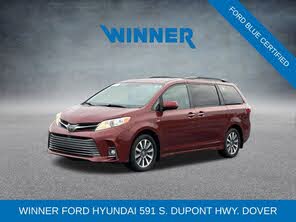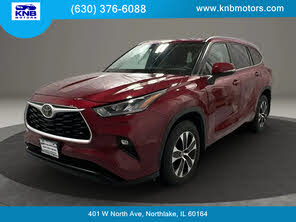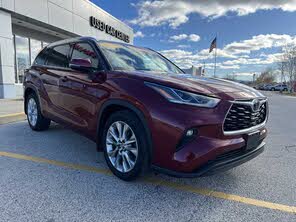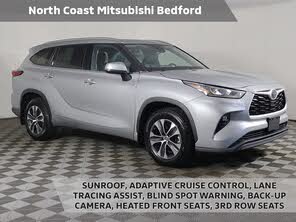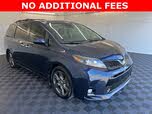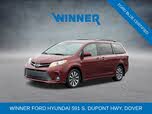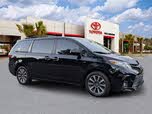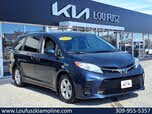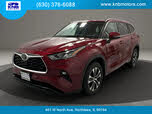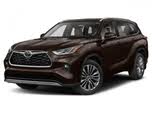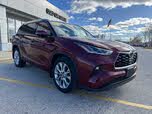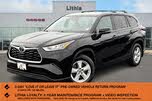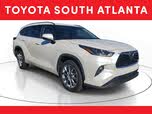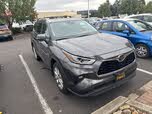2020 Toyota Sienna vs 2020 Toyota Highlander
Overview | |
MSRP$29,715 | MSRP$34,600 |
Listings436 | Listings719 |
Ratings & Reviews | |
User Reviews | User Reviews |
Expert reviews7.8 out of 10 | Expert reviews7.7 out of 10 |
Pros
Cons
| Pros
Cons
|
2020 Toyota Sienna Reviews SummarySince the second half of the 20th century, each decade has had a hot-topic family car, and, as we’ve noted in a number of reviews this year, the crossover is our current darling vehicle. Before the crossover, there were big, truck-based SUVs. Before that, there were station wagons. And for the past 35 years, there's always been the minivan. The Dodge Caravan has been widely considered the Patient Zero of the minivan segment. From there, seemingly everyone joined the party, including Toyota, Nissan, Ford, Chevy, GMC, Volkswagen, Oldsmobile, Ford, and more. Heck, even Mercury had a “Nautica Edition” version of the Villager. The minivan was king once, the crossover is king now, and some other type of vehicle will likely dominate in the near future. But in all this, the 7- and 8-passenger minivans will always represent the ultimate in versatility. The crossover is an image-forward fad with a dash of usability, but the minivan continues to prove itself as the pinnacle of practicality. The 2020 Toyota Sienna is neither the newest nor flashiest minivan out there, but when you absolutely need space for people and gear, there’s nothing better. Additionally, the Sienna is the only minivan to offer all-wheel drive (AWD), which is something specifically desired by many car buyers. | |
2020 Toyota Highlander Reviews SummaryMidsize three-row SUVs are all spacious and powerful, but only the Toyota Highlander reaches the premium threshold for passenger comfort. Redesigned for 2020, the Highlander's revised styling and technology are secondary to its silent operation, soft ride, and cosseting interior. The upper trims feel and drive just like a Lexus, without the upcharge. There is nothing exciting about a Highlander, and yet, there is no other SUV in the $35,000 to $50,000 range that feels so effortless and tranquil. | |
Popular Features & Specs | |
Engine3.5L 296 hp V6 | Engine3.5L 295 hp V6 |
Drive TrainFWD | Drive TrainFWD |
Seating Capacity2 | Seating Capacity8 |
Horsepower296 hp @ 6200 rpm | Horsepower295 hp @ 6600 rpm |
MPG City19 | MPG City20 |
MPG Highway26 | MPG Highway28 |
Engine | |
Engine Name3.5L 296 hp V6 | Engine Name3.5L 295 hp V6 |
Torque263 lb-ft @ 4700 rpm | Torque263 lb-ft @ 4700 rpm |
Horsepower296 hp @ 6200 rpm | Horsepower295 hp @ 6600 rpm |
DrivetrainFWD | DrivetrainFWD |
Fuel Economy | |
MPG City19 | MPG City20 |
MPG Highway26 | MPG Highway28 |
Interior | |
Seating Capacity2 | Seating Capacity8 |
Safety | |
Front Crash Overall4 | Front Crash Overall4 |
Side Crash Overall5 | Side Crash Overall5 |
Dimensions & Capacity | |
Cargo Space | Cargo Space16.0 cu ft |
Curb Weight4375 lbs | Curb Weight4145 lbs |
Height68.9 in | Height68.1 in |
Length200.2 in | Length194.9 in |
Width78.1 in | Width76.0 in |
Wheelbase119.3 in | Wheelbase112.2 in |
Maximum Payload | Maximum Payload1685 lbs |
Number of doors4 | Number of doors4 |
Maximum Towing Capacity | Maximum Towing Capacity5000 lbs |
Overview | ||
MSRP | $29,715 | $34,600 |
Listings | ||
Ratings & Reviews | ||
User reviews | ||
Expert reviews | 7.8 out of 10Read full review | 7.7 out of 10Read full review |
Pros & cons | Pros
Cons
| Pros
Cons
|
Summary | Since the second half of the 20th century, each decade has had a hot-topic family car, and, as we’ve noted in a number of reviews this year, the crossover is our current darling vehicle. Before the crossover, there were big, truck-based SUVs. Before that, there were station wagons. And for the past 35 years, there's always been the minivan. The Dodge Caravan has been widely considered the Patient Zero of the minivan segment. From there, seemingly everyone joined the party, including Toyota, Nissan, Ford, Chevy, GMC, Volkswagen, Oldsmobile, Ford, and more. Heck, even Mercury had a “Nautica Edition” version of the Villager. The minivan was king once, the crossover is king now, and some other type of vehicle will likely dominate in the near future. But in all this, the 7- and 8-passenger minivans will always represent the ultimate in versatility. The crossover is an image-forward fad with a dash of usability, but the minivan continues to prove itself as the pinnacle of practicality. The 2020 Toyota Sienna is neither the newest nor flashiest minivan out there, but when you absolutely need space for people and gear, there’s nothing better. Additionally, the Sienna is the only minivan to offer all-wheel drive (AWD), which is something specifically desired by many car buyers. | Midsize three-row SUVs are all spacious and powerful, but only the Toyota Highlander reaches the premium threshold for passenger comfort. Redesigned for 2020, the Highlander's revised styling and technology are secondary to its silent operation, soft ride, and cosseting interior. The upper trims feel and drive just like a Lexus, without the upcharge. There is nothing exciting about a Highlander, and yet, there is no other SUV in the $35,000 to $50,000 range that feels so effortless and tranquil. |
Video | ||
Popular Features & Specs | ||
Engine | 3.5L 296 hp V6 | 3.5L 295 hp V6 |
Drive Train | FWD | FWD |
Seating Capacity | 2 | 8 |
Horsepower | 296 hp @ 6200 rpm | 295 hp @ 6600 rpm |
MPG City | 19 | 20 |
MPG Highway | 26 | 28 |
Engine | ||
Engine Name | 3.5L 296 hp V6 | 3.5L 295 hp V6 |
Torque | 263 lb-ft @ 4700 rpm | 263 lb-ft @ 4700 rpm |
Horsepower | 296 hp @ 6200 rpm | 295 hp @ 6600 rpm |
Drivetrain | FWD | FWD |
Fuel Economy | ||
MPG City | 19 | 20 |
MPG Highway | 26 | 28 |
Interior | ||
Seating Capacity | 2 | 8 |
Safety | ||
Front Crash Overall | 4 | 4 |
Side Crash Overall | 5 | 5 |
Dimensions & Capacity | ||
Cargo Space | 16.0 cu ft | |
Curb Weight | 4375 lbs | 4145 lbs |
Height | 68.9 in | 68.1 in |
Length | 200.2 in | 194.9 in |
Width | 78.1 in | 76.0 in |
Wheelbase | 119.3 in | 112.2 in |
Maximum Payload | 1685 lbs | |
Number of doors | 4 | 4 |
Maximum Towing Capacity | 5000 lbs | |
The 2020 Toyota Sienna, representing the third generation, had been on the market since its 2011 introduction, receiving a notable update in 2018 that aimed to modernize its infotainment features and overall appearance. Despite these updates, the 2020 Sienna still conveyed a somewhat dated aesthetic. Although the interior could occasionally feel upscale, the hollow “thud” produced when slamming the front doors illustrated some gaps in fit and finish that other automakers might address. The instrument panel design seemed plucked from Toyota's 2010 era parts bin, favoring simplicity over modern flair. This straightforward approach did aid in ease of use, especially for basic controls.
The Sienna was offered in an array of trims—L, LE, SE, SE Premium, XLE, XLE Premium, Limited, and Limited Premium. The base L trim came equipped with 17-inch alloy wheels, remote keyless entry, three-zone climate control, five USB ports, Bluetooth, a WiFi hot spot, and a 7-inch touchscreen with Apple CarPlay and Amazon Alexa.
The LE trim added features like dual power sliding doors, black roof rails, easy-clean upholstery, manual second- and third-row sunshades, and an overhead driver console for the power sliding second-row doors. Moving up to the SE trim, recommended by CarGurus for its additional features, one would find 19-inch alloy wheels, a mesh grille, fog lights, sport instrumentation, heated front seats, and leather upholstery, along with a highly practical power rear liftgate.
On the higher SE Premium, features included chrome-accented door handles, a power moonroof, 19-inch gunmetal alloy wheels, a DVD entertainment system, and an EasySpeak intercom system. The XLE trim offered 17-inch alloy wheels, leather-trimmed seating, heated front seats, and woodgrain accents, while the Limited trim added leather front seats and higher-end audio systems. Finally, the Limited Premium mirrored the SE Premium plus HID headlights and rain-sensing wipers. The Nightshade Edition provided dark accents and wheels for those prioritizing a stylish look.
Conversely, the 2020 Toyota Highlander featured a design that was modern but somewhat unremarkable. Internal to the Highlander, Toyota invested effort reflecting a high-quality fit and finish with thoughtfully placed silver-painted accents. The multi-layered dash, an 8-inch touchscreen, and polished black plastic climate controls illustrated Toyota's emphasis on fostering a refined ambiance. Even the base L's fabric seats conveyed a sense of quality.
Higher trims like the Limited offered a three-tone interior with padded surfaces and rich textures abundant, save for the door panels' middle portions. On the Platinum trim, additional luxuries such as diamond-quilted seat backrests added sophistication. Exteriorly, refinements were subtle, with elements like new paint colors boosting appeal modestly. However, the modern design was somewhat overshadowed by higher trims' inclusion of features like big 20-inch wheels and sleek trapezoidal accents defining various design elements like the grille and tailgate. Overall, the Highlander's interior prided itself on equal parts comfort and functionality, outshining many competitors.


















Under the hood, every 2020 Toyota Sienna came equipped with a 3.5-liter V6 engine that delivered 296 horsepower and 263 pound-feet of torque, paired with an 8-speed automatic transmission. The throttle response could be sharpened in Sport mode, while the manual shifting capabilities were rarely deemed necessary. Front-wheel drive (FWD) was standard, but all trims beyond the base L offered all-wheel drive (AWD), which necessitated dropping to a 7-passenger configuration. The Sienna managed stout acceleration in normal Drive mode, with the ability to tow up to 3,500 pounds.
Fuel economy was another area where the Sienna held its ground relatively well. The FWD variants posted 19 mpg city, 26 mpg highway, and 21 mpg combined. AWD variants saw a slight dip to 18/24/20 mpg. Handling was another surprise—Sienna's low center of gravity and wide base allowed it to corner effectively for its class, though the twitchy steering response at high speeds could call for constant driver attention.
On the performance front, the 2020 Toyota Highlander also boasted a 3.5-liter V6 engine, mustering 295 horsepower and 263 pound-feet of torque through an eight-speed automatic transmission. It was available in both FWD and AWD, providing brisk acceleration without turbochargers' need—credit to this same engine being used in the Lexus RX. However, the heavy foot required to prompt a kickdown resembled the character of a lazy luxury engine more than a spirited SUV.
Handling was a bit of a letdown. Despite being built on a new, stiffer chassis shared with the Toyota RAV4, the Highlander's soft suspension induced excessive rebound. This, coupled with its loose steering, resulted in a vehicle that bobbed and floated at speed, less precise than the Sienna. Although upper trims like the Limited and Platinum offered torque vectoring on the rear axle and selectable driving modes, their benefits were marginal. Fuel economy ratings were competitive, with FWD models achieving 21 mpg city, 29 mpg highway, and 24 mpg combined, while AWD variants returned 20/27/23 mpg.
In terms of utility, the 2020 Toyota Sienna excelled with a class-leading 150 cubic feet of cargo space, slightly surpassing competitors like the Chrysler Pacifica (140.5 cubic feet), Honda Odyssey (144.9 cubic feet), Dodge Caravan (143.8 cubic feet), and Kia Sedona (142 cubic feet). Achieving this required removing the second-row seats—an easy task with captain's chairs, but laborious with the second-row bench. The third-row seats folded seamlessly into the floor, offering versatility against its more cumbersome second-row arrangement.
For passengers, getting into the back row could be challenging as the second-row seats' fold-and-slide mechanism was somewhat clunky. Toyota also featured a built-in rotating lift seat for mobility access, a unique and practical offering from the dealership.
The 2020 Toyota Highlander could seat up to eight or seven with the second-row captain's chairs, which were standard on the Limited and Platinum trims. The second-row seats were noted for their versatility, allowing significant fore/aft and reclining adjustments. Even better, the rear doors opened widely for easy ingress and egress. Three-zone climate control, a 120-volt outlet, side window shades, and heated second-row seats featured prominently on upper trims, while the Platinum added the luxury of a panoramic moonroof.
Cargo capacities for the Highlander were competitive—16 cubic feet behind the third row, 48 cubic feet behind the second, and 84 cubic feet with both folded. Additionally, pluses like six tie-down hooks and a second 120-volt outlet on the Hybrid model were bonus points, even though it trailed the Sienna in total cargo volume. Ergonomically, the Highlander facilitated easy access across all seating areas without requiring occupants to step up or duck down significantly.
The 2020 Toyota Sienna’s base L trim came standard with a 7-inch touchscreen featuring Toyota’s proprietary infotainment software, Apple CarPlay, Amazon Alexa, Bluetooth connectivity, five USB ports, and a WiFi hotspot. Higher trims added features like navigation and a JBL 10-speaker premium audio system. The unique Driver Easy Speak system broadcasted the driver's voice to rear speakers, a characteristic novelty embracing family-friendly communication.
In stark contrast, the 2020 Toyota Highlander featured a significantly larger optional 12.3-inch touchscreen on the Limited trim and standard on the Platinum. However, it fell short of expectations due to a cluttered interface and persistent display elements that minimized the usability of its full screen. Standard technology included Apple CarPlay, Android Auto, Amazon Alexa integration, and a comprehensive suite of safety features led by a semi-automated driving system with adaptive cruise control and road sign detection. The head-up display and instrument cluster were praised for their clarity and informativeness, helping to make up for the less impressive main display.
Safety was a strong suit for the 2020 Toyota Sienna. Despite its twitchy steering, TSS-P (Toyota Safety Sense) ensured safety with lane-departure warning, lane-keep assist, forward-collision warning and avoidance with pedestrian detection, dynamic cruise control, and automatic high beams. Blind-spot monitoring became standard on higher trims. The Sienna earned a five-star rating from NHTSA and high marks from IIHS, including a top mark of Superior for its driver-assistance features.
The 2020 Toyota Highlander came with Toyota Safety Sense 2.0, offering similar capabilities—automatic emergency braking with pedestrian and cyclist detection, lane-keeping assist, adaptive cruise control, automatic high beams, and optional blind-spot monitoring, parking sensors, and rear emergency braking. Standard airbags included a driver's knee airbag and a special cushion airbag for the front passenger. It achieved a 2020 Top Safety Pick from IIHS and all six crash tests' top rating, although NHTSA had not yet rated it.
CarGurus highlights
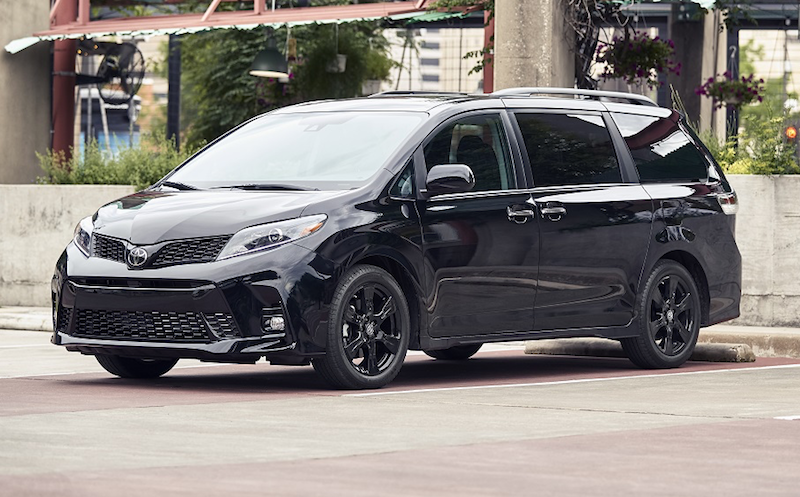
According to CarGurus experts, the overall rating for the 2020 Toyota Sienna is 7.8 out of 10, while the 2020 Toyota Highlander scores 7.7 out of 10. Between these two Toyota offerings, the Sienna edges out slightly based on its broader functionality, extensive cargo space, and AWD option. The Highlander remains a strong contender and may be the preferred choice for those emphasizing interior quality and modern tech, but for all-around family utility, the Sienna is the recommended pick.
Choose the 2020 Toyota Sienna if:
- You need maximum cargo space and the ability to completely remove the second-row seats.
- You prioritize family-oriented features like the Driver Easy Speak intercom system and a built-in rotating lift seat.
- You prefer a minivan that offers all-wheel drive capability in a sea of front-wheel-drive competitors.
Choose the 2020 Toyota Highlander if:
- You desire a more modern, sophisticated interior with high-quality materials and additional tech features.
- You want a vehicle with versatile seating configurations, including captain’s chairs for easier access and comfort.
- You need a family-friendly vehicle offering strong fuel economy, competitive cargo space, and advanced safety technology.
CarGurus highlights

According to CarGurus experts, the overall rating for the 2020 Toyota Sienna is 7.8 out of 10, while the 2020 Toyota Highlander scores 7.7 out of 10. Between these two Toyota offerings, the Sienna edges out slightly based on its broader functionality, extensive cargo space, and AWD option. The Highlander remains a strong contender and may be the preferred choice for those emphasizing interior quality and modern tech, but for all-around family utility, the Sienna is the recommended pick.
Choose the 2020 Toyota Sienna if:
Shop Now- You need maximum cargo space and the ability to completely remove the second-row seats.
- You prioritize family-oriented features like the Driver Easy Speak intercom system and a built-in rotating lift seat.
- You prefer a minivan that offers all-wheel drive capability in a sea of front-wheel-drive competitors.
Choose the 2020 Toyota Highlander if:
Shop Now- You desire a more modern, sophisticated interior with high-quality materials and additional tech features.
- You want a vehicle with versatile seating configurations, including captain’s chairs for easier access and comfort.
- You need a family-friendly vehicle offering strong fuel economy, competitive cargo space, and advanced safety technology.

By: CarGurus + AI
At CarGurus, our team of experienced automotive writers remain at the heart of our content operation, conducting hands-on car tests and writing insightful guides that are backed by years of industry experience. To complement this, we are harnessing AI to make our content offering more diverse and more helpful to shoppers than ever. To achieve this, our AI systems are based exclusively on CarGurus content, ratings and data, so that what we produce is both unique to CarGurus, and uniquely helpful to car shoppers.



